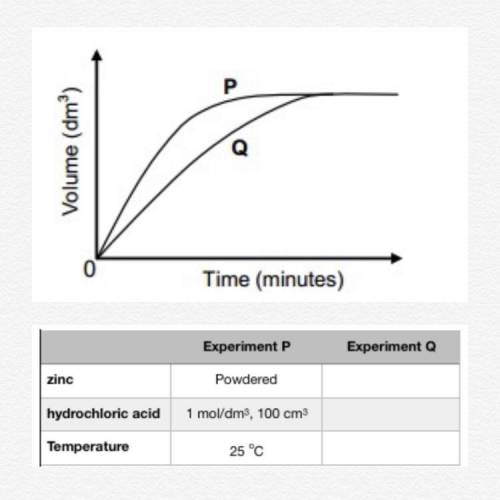
Please help , don’t answer if u don’t know please
An experiment is carried out to investigate the rate at which hydrogen gas is produced when a given amount of zinc reacts with an excess of a dilute hydrochloric acid solution. Curve P on the graph below shows the volume of hydrogen gas formed when 100 cm3 of a 1 mol/dm3 solution is used. (Reaction rate is indicated by the slope of the graphs.)
Zn + 2 HCl = ZnCl2 + H2
a. Design an experiment that would produce curve Q on the graph below. (Hint: change the experimental parameters so that the rate of gas evolution changes according to the curves). You can also use the table to record your data.
b. What is the implication of the fact that the two curves touch? Explain.
c. Give a reason why the rate of hydrogen production slows down towards the end in both experiments.


Answers: 2
Another question on Chemistry

Chemistry, 22.06.2019 13:10
The last few miles of the marathon are the most difficult for heather, her hair plastered to her head, sweat clinging to her arms, and her legs already feeling as if they had nothing left, just dead weight. after grabbing a cup of ice water, she feels the ice cubes smash against her nose as she gulps some cool refreshment and keeps on running. in these last few miles, the breeze kicks up and she finally feels some coolness against her skin. drips of sweat, once clinging to her forehead, now spill down, and heather feels more pain as the sweat flows into her eyes.which of the following is the most likely reason why the ice struck heather’s nose when she took a drink? a) water can function as a solvent. b) water can store large amounts of heat. c) water can moderate temperatures through evaporative cooling. d) the density of water decreases when it freezes. e) water has a cohesive nature.sweat remained on heather’s forehead and arms because of the a) high salt content of sweat b) cohesive nature of water c) ability of water to moderate heat d) high evaporative cooling effect of water e) ability of water to act as a solvent
Answers: 1

Chemistry, 22.06.2019 17:00
In a heat engine of 1000 j of heat enters the system and the piston does 500 j of work what is the final internal energy of the system if the inital energy was 2000 j we have to do all of these down here 1)write the equation 2)list out your know variables 3)plug the numbers into the equations 4)solve 5)write your solution statemtn that includes inital energuy and final energuy added
Answers: 1

Chemistry, 22.06.2019 19:00
How many liters of ethylene glycol antifreeze (c2h6o2), with a density of 1.100 g/l, would you add to your car radiator containing 15.0 kg of water if you needed to protect your engine to - 21.5°c? for water, kf = 1.86°c m -1.
Answers: 1

Chemistry, 22.06.2019 19:20
For a research project, a student decided to test the effect of the lead(ii) ion (pb2+) on the ability of salmon eggs to hatch. this ion was obtainable from the water‐soluble salt, lead(ii) nitrate, which the student decided to make by the following reaction. pbo(s) + 2 hno3(aq) → pb(no3)2(aq) + h2o losses of product for various reasons were expected, and a yield of 86.0% was expected. in order to have 5.00 g of product at this yield, how many grams of pbo should be reacted? (assume that sufficient nitric acid, hno3, would be used.)
Answers: 1
You know the right answer?
Please help , don’t answer if u don’t know please
An experiment is carried out to investigate the r...
Questions

Mathematics, 31.03.2020 17:03

Mathematics, 31.03.2020 17:03

Chemistry, 31.03.2020 17:03





Biology, 31.03.2020 17:03

Biology, 31.03.2020 17:03

Social Studies, 31.03.2020 17:03


Mathematics, 31.03.2020 17:03

Biology, 31.03.2020 17:03



Mathematics, 31.03.2020 17:03



Social Studies, 31.03.2020 17:03



